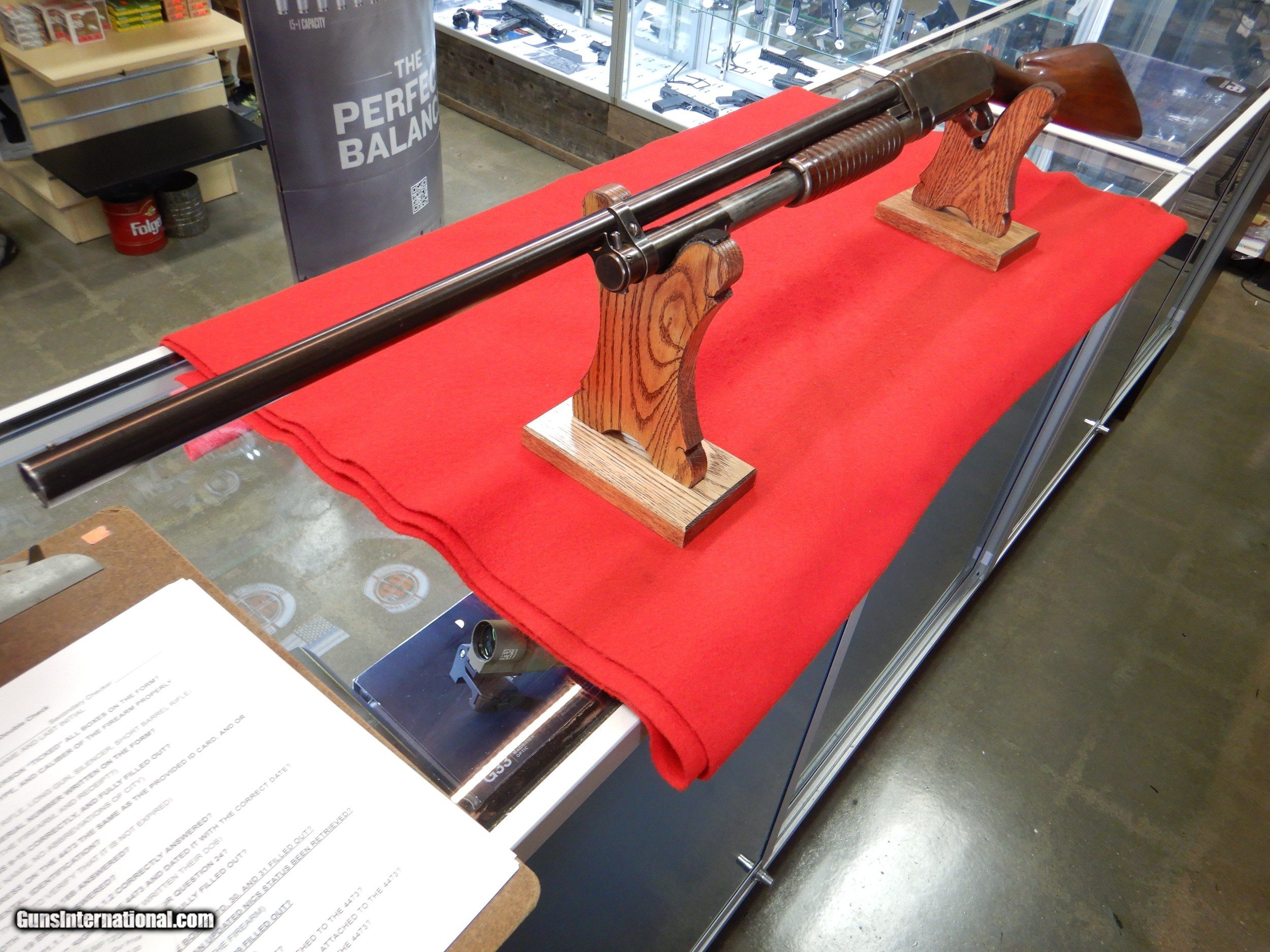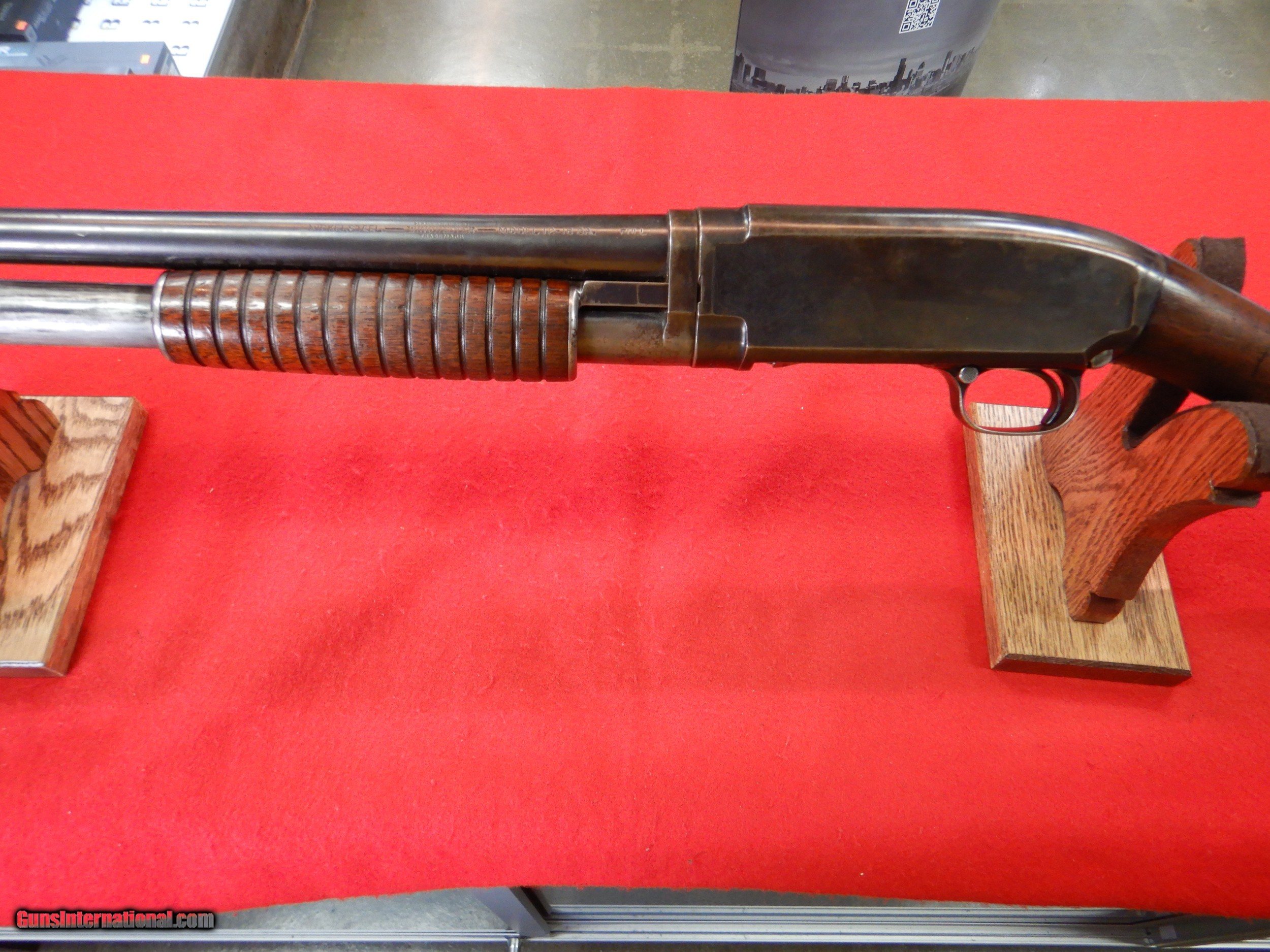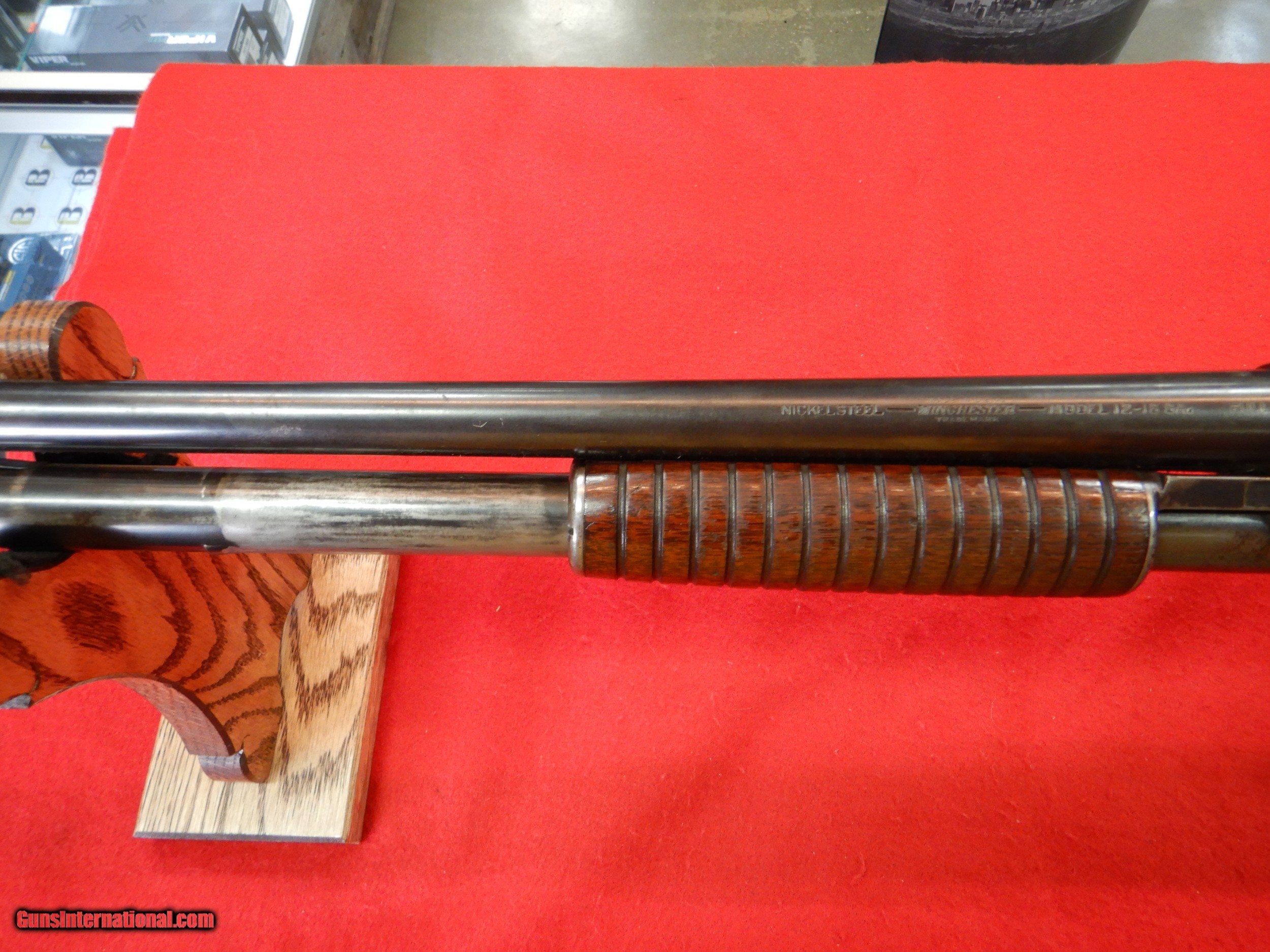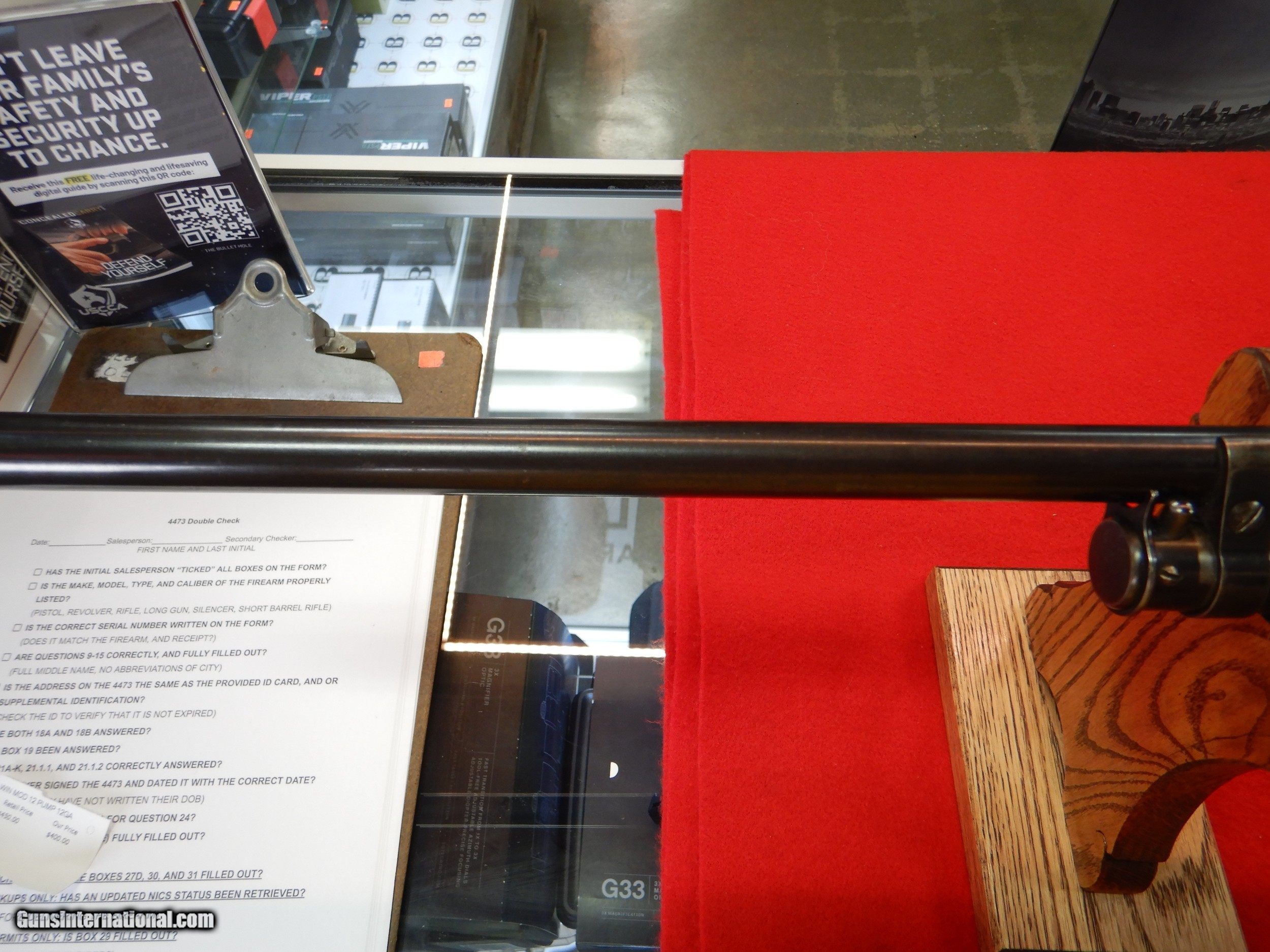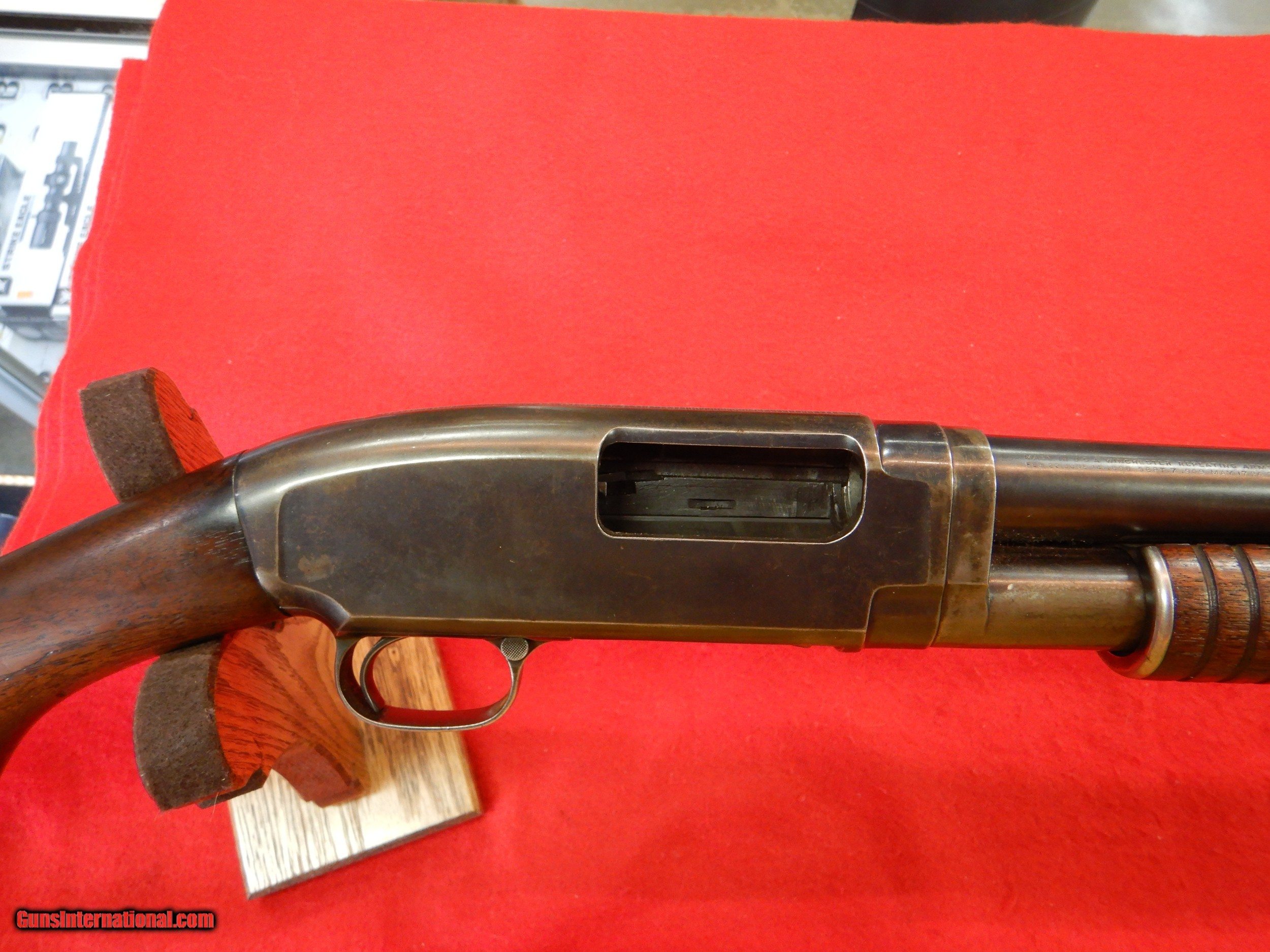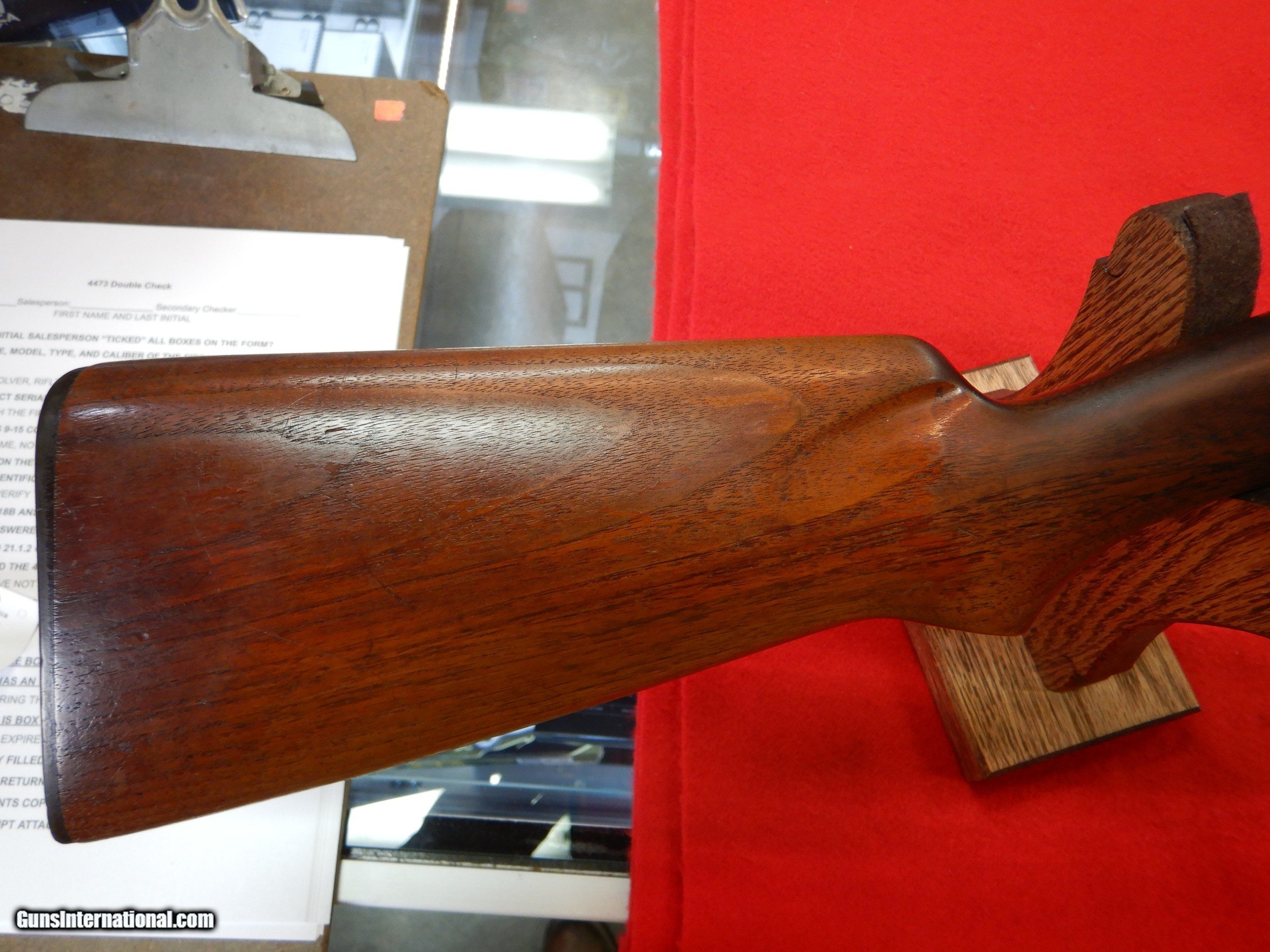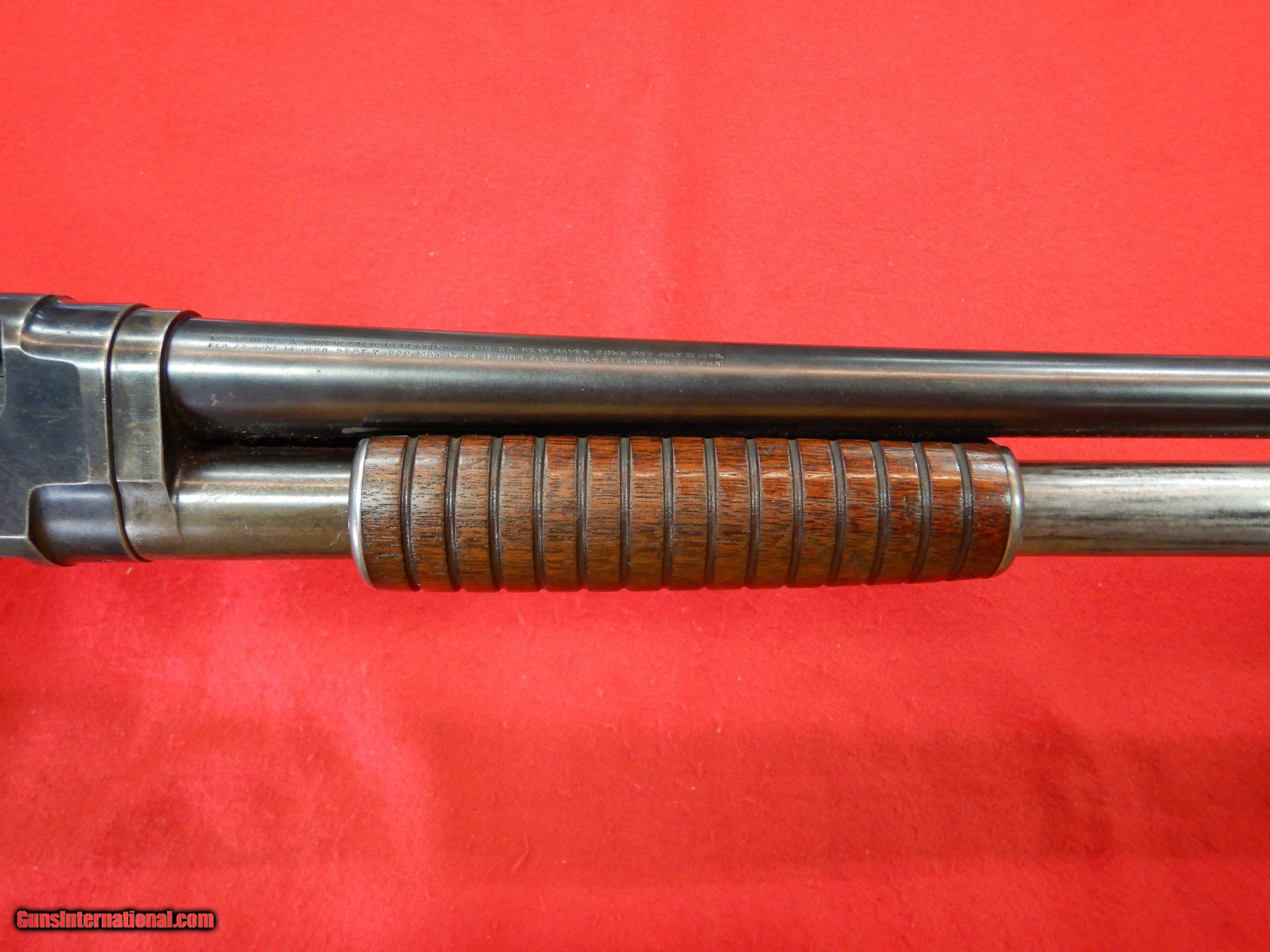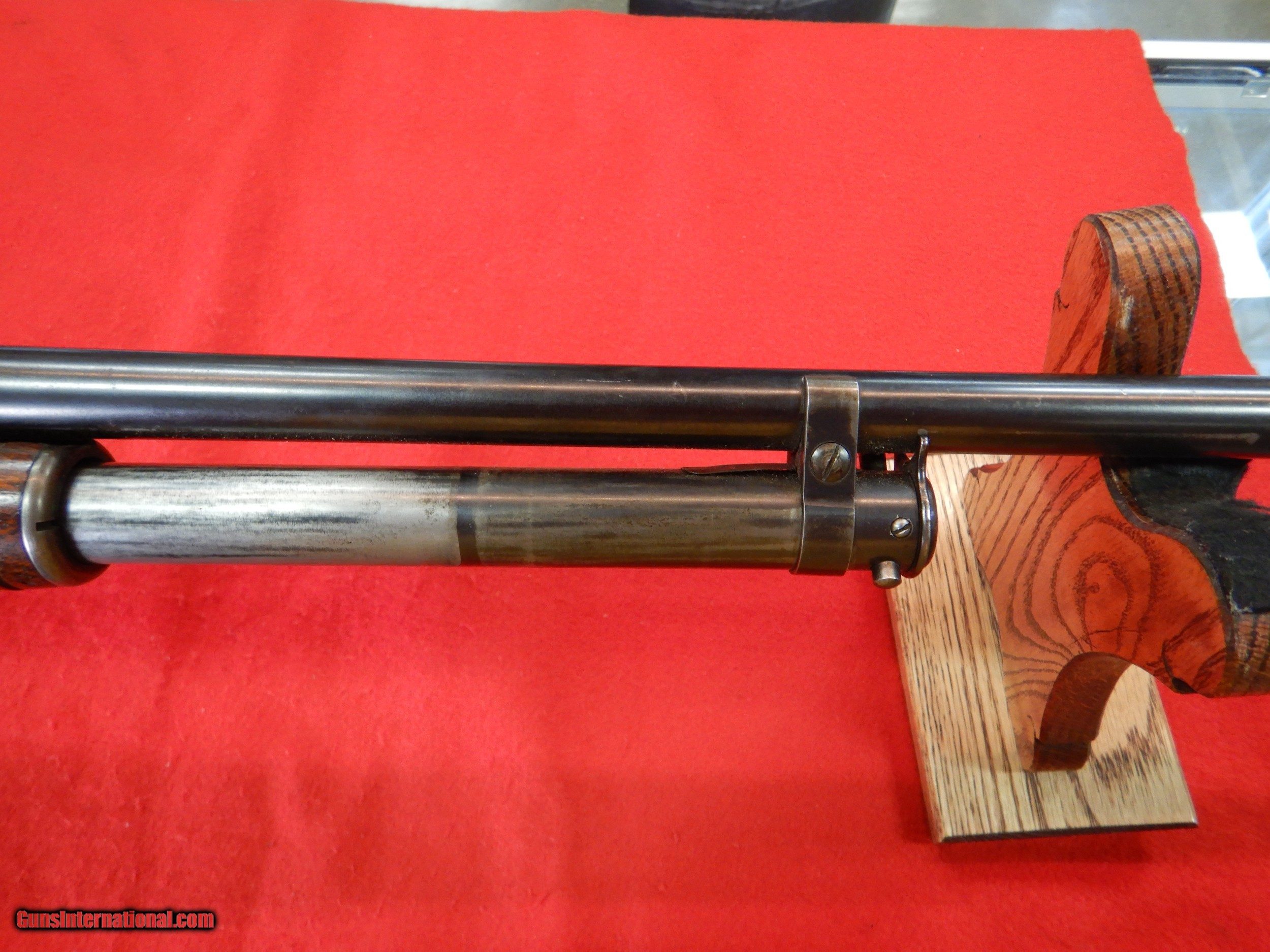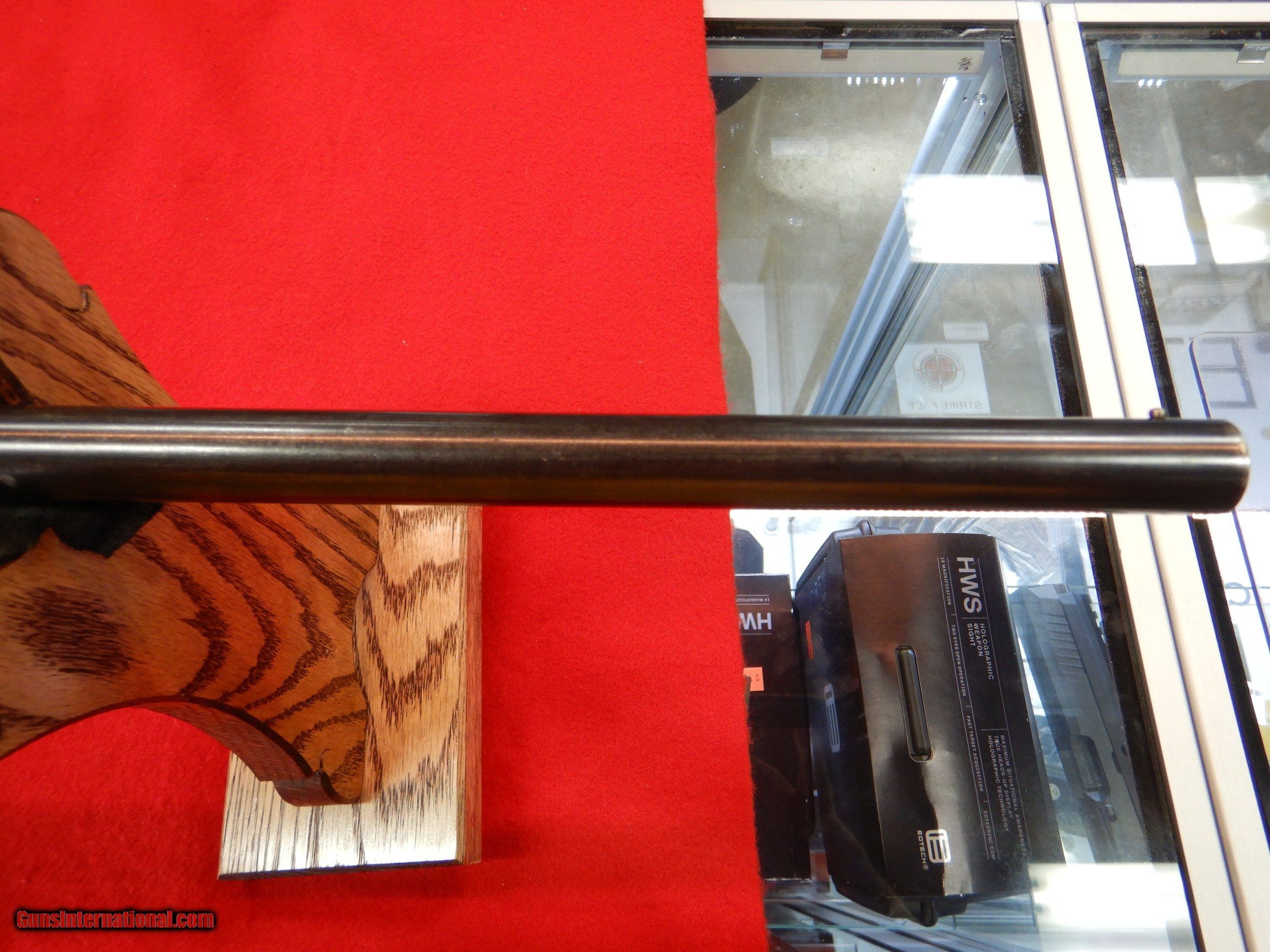Your Session is Ending
 The server has not detected any activity for the last 3 hours.
For your security, your session will expire in 2 minutes and you will be redirected to the Sign In page.
Would you like to stay signed in?
The server has not detected any activity for the last 3 hours.
For your security, your session will expire in 2 minutes and you will be redirected to the Sign In page.
Would you like to stay signed in?
WINCHESTER MODEL 12 PUMP SHOTGUN PRE-OWNED 16 GA.
WINCHESTER MODEL 12 PUMP SHOTGUN PRE-OWNED 16 GA.
Guns International #: 102063450
Category - Winchester Shotguns
- Winchester Shotguns - Model 12
Seller's Information
When emailing or calling sellers direct,
please mention that you saw their listing on GunsInternational.com
Seller: The Bullet Hole
Member Since: 7/17/19
State:
Kansas
Zip: 66202
Country: United States
Phone:
(913) 432-0050
Seller Type: FFL Dealer
Return Policy: 3 day inspection and return policy on used guns and accessories.
Payment Methods: Credit Card or Cashier's Check
WINCHESTER MODEL 12 PUMP SHOTGUN PRE-OWNED 16 GA.
Description:
TODAY WE HAVE A WINCHESTER MODEL 12 PUMP ACTION SHOTGUN IN 16 GA. SPECS ARE AS FOLLOWS;
USED - GOOD CONDITION
Winchester Model 12 Pump Shotgun - 16ga.
SHOTGUN HISTORY
Pump- or slide-action long guns have been around for a long time. Alexander Bain of Britain received the first patent for a pump action in 1854. During the latter part of the 19th Century Winchester, which was the recognized leader in lever-action repeating rifles, tasked John Browning with providing the company with its first repeating shotgun, and because Winchester was all about lever action it wanted its repeater to be a lever-gun as well. Browning responded with what would be known as the Model 1887 shotgun. The 1887 enjoyed some success, but it did have some handling and reliability issues.
Winchester eventually ceded to Browning the notion that a pump-action shotgun would be a better, more reliable repeater. In 1893 the company introduced a slide-action shotgun designed by Browning. There were immediate issues with the Model 1893, one of which was the 1893 was designed for black powder shells. Ammo companies were rapidly changing to smokeless powder in their shotshells, and Winchester's brass were terrified that they would be vulnerable to lawsuits from people injured from shooting smokeless loads in the blackpowder Model '93. Within four years Winchester redesigned the Model '93 into the Model 1897, replete with a solid-top receiver and 2 3/4" chambers. Another safety feature was incorporated so that the fore-end had to be pushed forward slightly to unlock the bolt before the action could be operated. It may have been the first instance of a product recall in America; Winchester offered to buy back or exchange a Model '97 for a Model '93. The Model '97 was a solid shotgun with more than a million copies made during its 60-year production run.
Thomas Crossley (TC) Johnson came to work at Winchester as a 23-year-old engineer in1885. Johnson would eventually be responsible for no less than eight of Winchester's most iconic firearms. Soon after the turn of the 20th century Johnson began to work on a more modern design than that of the Model '97. competition for marketplace share was intense between gunmakers, and all of them invested heavily into keeping themselves ahead of the technological and design curve. The most objectionable feature of the Model '97 was that damnable exposed hammer. It just seemed offensible to the sensibilities of a refined shooter. The fix that Johnson came up with was to simply hide the hammer inside an enclosed and streamlined receiver.
Johnson also redesigned the internals. Whereas the Model '97 used a carrier or shell lifter that does double duty to lock the bolt, the Model 1912 locks the bolt directly into the receiver and has a separate bolt release activated by pulling the trigger or pushing a button at the rear of the trigger guard. The carrier is hinged at its rear and under spring tension so that when the bolt is in battery it is more or less flush with the bottom of the receiver. This arrangement is stronger than that of the 1897, though the older shotgun has never been criticized for a lack of strength. Like the Mode '97, the Model 1912 was not originally produced with a disconnector, meaning that a shooter can hold the trigger down and fire the gun by simply operating the slide. This feature seems to mostly impress people who know little about guns or how to used them, as well as the movie going public.
The Model 12-as it became known after 1919-was made from the finest steel alloys of the time. Parts were forged and required extensive, and often complicated, machining to produce them. Winchester's marketing guys immediately christened it the "Perfect Repeater," and like a lot of those old Winchester nicknames, it struck a chord with the shooting public and became common in usage. All of this came at a price, of course. The Model 12 was about 40 percent more expensive than the '97, yet it consistently outsold its older brother during the 45-year-span they shared in the Winchester catalog.
When it was introduced, the Model 12 was only available in 20 gauge, 12- and 16-gauge. Model 12s became available in late 1913. A 28-gauge Model 12 was brought out in 1934. Sadly, this is the rarest of Model 12s, probably as a result of The Depression and the fact that the 28-gauge-as wonderful as it is-was the prerogative of those with a fair amount of discretionary cash, something sorely lacking during The Depression and World War II. In 1933 a completely scaled down version of the Model 12-the Model 42-came out in .410 bore.
Like most of the great Winchesters, the Model 12 had its ups and downs. During its heyday it was made in Field, Skeet, Trap, Tournament and Super Pigeon grades, the differences primarily being in grades of walnut and engraving. The Heavy Duck Gun was never marked as such. Rather, it was roll marked with "Super Speed and Super X." These guns were chambered for 3" magnum shells and debuted in 1935. Some were made with solid rib; other had a vent rib, but most were plain barreled. A Featherweight model came out in 1961. Beginning in 1928 some Model 12s came from the factory with a Cutts Compensator, this feature was discontinued in 1954. Some were also equipped with the competing Polychoke.
While the majority of Model 12s were field guns, quite a few saw service in the military and law enforcement. Model 12 Trench Guns were produced on special order to the military in 1919. Riot gun versions-again on special order-came about in 1918 and were produced for the subsequent 45 year. All of these marshal shotguns were available in 12 gauge only.
For much of its production run the Model 12 was the repeating shotgun that all others were judged by. Its smooth operation and reliability remains legendary among knowledgeable shotgunners. The fact that it was more expensive than its competitors meant virtually nothing, but eventually it became the shotgun's undoing. When Remington brought out its Model 870 in 1950, the Model 12 would start feeling its age. The Remington looked almost as good as the Model 12-aficionados can tell them apart in their sleep-and the upstart was as reliable and fast handling as the older Model 12. Post-war production costs were headed into the stratosphere. The increasing costs combined with market share loss put the Model 12 on the chopping block during the infamous 1964 reorganization of the Winchester product line. Customers and gun writers screamed like a calf being branded, but as a stock friend of mine once said, "Never underestimate the power of money." The Model 12 as a production gun was finished.
A few Model 12s leaked out of the Custom Shop until 1980. Another limited run-more like a trickle-was done from 1993 until 2006 by Miroku for USRAC. but the notion that function is everything and form must conform to function, aesthetics be dammed has shoved aside the notion of elegance being a critical part of a sporting tool. Too, it has become more widely accepted that tools are consumable, and replacement is simply a part of doing business.
More than 2 million Model 12s were made, and that legend of smooth operation and durability has fueled some collector interest. Model 12s can be abused, left out in the elements, dropped, kicked or worse and still keep shooting. Given even minimal care, however, a Model 12 will outlast virtually any other pump-gun. If you can find one, a Model 12 is well worth the investment.
A Look Back at the Winchester Model 12 Shotgun by Dave Campbell
**BUYER PAYS SHIPPING AND INSURANCE**
SOLD
Shotgun Gauge: 16 Gauge
Manufacturer: WINCHESTER
Model: 12
Serial Number: 469979
Barrel Length: 28
Condition: GOOD
Metal Condition: GOOD
Wood Condition: GOOD
Bore Condition: GOOD
Description:
TODAY WE HAVE A WINCHESTER MODEL 12 PUMP ACTION SHOTGUN IN 16 GA. SPECS ARE AS FOLLOWS;
USED - GOOD CONDITION
Winchester Model 12 Pump Shotgun - 16ga.
- 16 gauge
- 28" Full Choke Barrel
- 2 3/4" Chamber
- Single Bead Front Sight
- Manual Trigger Safety
- 3+1 Tube Magazine
SHOTGUN HISTORY
Pump- or slide-action long guns have been around for a long time. Alexander Bain of Britain received the first patent for a pump action in 1854. During the latter part of the 19th Century Winchester, which was the recognized leader in lever-action repeating rifles, tasked John Browning with providing the company with its first repeating shotgun, and because Winchester was all about lever action it wanted its repeater to be a lever-gun as well. Browning responded with what would be known as the Model 1887 shotgun. The 1887 enjoyed some success, but it did have some handling and reliability issues.
Winchester eventually ceded to Browning the notion that a pump-action shotgun would be a better, more reliable repeater. In 1893 the company introduced a slide-action shotgun designed by Browning. There were immediate issues with the Model 1893, one of which was the 1893 was designed for black powder shells. Ammo companies were rapidly changing to smokeless powder in their shotshells, and Winchester's brass were terrified that they would be vulnerable to lawsuits from people injured from shooting smokeless loads in the blackpowder Model '93. Within four years Winchester redesigned the Model '93 into the Model 1897, replete with a solid-top receiver and 2 3/4" chambers. Another safety feature was incorporated so that the fore-end had to be pushed forward slightly to unlock the bolt before the action could be operated. It may have been the first instance of a product recall in America; Winchester offered to buy back or exchange a Model '97 for a Model '93. The Model '97 was a solid shotgun with more than a million copies made during its 60-year production run.
Thomas Crossley (TC) Johnson came to work at Winchester as a 23-year-old engineer in1885. Johnson would eventually be responsible for no less than eight of Winchester's most iconic firearms. Soon after the turn of the 20th century Johnson began to work on a more modern design than that of the Model '97. competition for marketplace share was intense between gunmakers, and all of them invested heavily into keeping themselves ahead of the technological and design curve. The most objectionable feature of the Model '97 was that damnable exposed hammer. It just seemed offensible to the sensibilities of a refined shooter. The fix that Johnson came up with was to simply hide the hammer inside an enclosed and streamlined receiver.
Johnson also redesigned the internals. Whereas the Model '97 used a carrier or shell lifter that does double duty to lock the bolt, the Model 1912 locks the bolt directly into the receiver and has a separate bolt release activated by pulling the trigger or pushing a button at the rear of the trigger guard. The carrier is hinged at its rear and under spring tension so that when the bolt is in battery it is more or less flush with the bottom of the receiver. This arrangement is stronger than that of the 1897, though the older shotgun has never been criticized for a lack of strength. Like the Mode '97, the Model 1912 was not originally produced with a disconnector, meaning that a shooter can hold the trigger down and fire the gun by simply operating the slide. This feature seems to mostly impress people who know little about guns or how to used them, as well as the movie going public.
The Model 12-as it became known after 1919-was made from the finest steel alloys of the time. Parts were forged and required extensive, and often complicated, machining to produce them. Winchester's marketing guys immediately christened it the "Perfect Repeater," and like a lot of those old Winchester nicknames, it struck a chord with the shooting public and became common in usage. All of this came at a price, of course. The Model 12 was about 40 percent more expensive than the '97, yet it consistently outsold its older brother during the 45-year-span they shared in the Winchester catalog.
When it was introduced, the Model 12 was only available in 20 gauge, 12- and 16-gauge. Model 12s became available in late 1913. A 28-gauge Model 12 was brought out in 1934. Sadly, this is the rarest of Model 12s, probably as a result of The Depression and the fact that the 28-gauge-as wonderful as it is-was the prerogative of those with a fair amount of discretionary cash, something sorely lacking during The Depression and World War II. In 1933 a completely scaled down version of the Model 12-the Model 42-came out in .410 bore.
Like most of the great Winchesters, the Model 12 had its ups and downs. During its heyday it was made in Field, Skeet, Trap, Tournament and Super Pigeon grades, the differences primarily being in grades of walnut and engraving. The Heavy Duck Gun was never marked as such. Rather, it was roll marked with "Super Speed and Super X." These guns were chambered for 3" magnum shells and debuted in 1935. Some were made with solid rib; other had a vent rib, but most were plain barreled. A Featherweight model came out in 1961. Beginning in 1928 some Model 12s came from the factory with a Cutts Compensator, this feature was discontinued in 1954. Some were also equipped with the competing Polychoke.
While the majority of Model 12s were field guns, quite a few saw service in the military and law enforcement. Model 12 Trench Guns were produced on special order to the military in 1919. Riot gun versions-again on special order-came about in 1918 and were produced for the subsequent 45 year. All of these marshal shotguns were available in 12 gauge only.
For much of its production run the Model 12 was the repeating shotgun that all others were judged by. Its smooth operation and reliability remains legendary among knowledgeable shotgunners. The fact that it was more expensive than its competitors meant virtually nothing, but eventually it became the shotgun's undoing. When Remington brought out its Model 870 in 1950, the Model 12 would start feeling its age. The Remington looked almost as good as the Model 12-aficionados can tell them apart in their sleep-and the upstart was as reliable and fast handling as the older Model 12. Post-war production costs were headed into the stratosphere. The increasing costs combined with market share loss put the Model 12 on the chopping block during the infamous 1964 reorganization of the Winchester product line. Customers and gun writers screamed like a calf being branded, but as a stock friend of mine once said, "Never underestimate the power of money." The Model 12 as a production gun was finished.
A few Model 12s leaked out of the Custom Shop until 1980. Another limited run-more like a trickle-was done from 1993 until 2006 by Miroku for USRAC. but the notion that function is everything and form must conform to function, aesthetics be dammed has shoved aside the notion of elegance being a critical part of a sporting tool. Too, it has become more widely accepted that tools are consumable, and replacement is simply a part of doing business.
More than 2 million Model 12s were made, and that legend of smooth operation and durability has fueled some collector interest. Model 12s can be abused, left out in the elements, dropped, kicked or worse and still keep shooting. Given even minimal care, however, a Model 12 will outlast virtually any other pump-gun. If you can find one, a Model 12 is well worth the investment.
A Look Back at the Winchester Model 12 Shotgun by Dave Campbell
**BUYER PAYS SHIPPING AND INSURANCE**
SOLD
Shotgun Gauge: 16 Gauge
Manufacturer: WINCHESTER
Model: 12
Serial Number: 469979
Barrel Length: 28
Condition: GOOD
Metal Condition: GOOD
Wood Condition: GOOD
Bore Condition: GOOD
Click Photo to Enlarge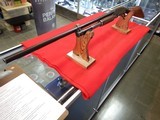
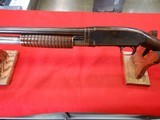
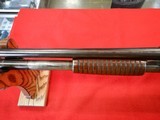
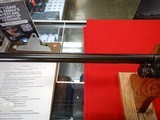
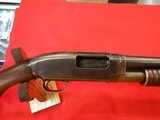
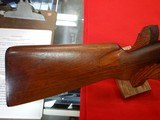
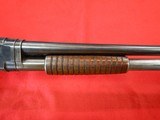
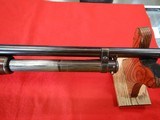
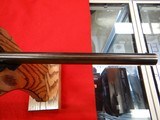
|
Guns International #: 102063450
Category - Winchester Shotguns
- Winchester Shotguns - Model 12
Seller's Information
When emailing or calling sellers direct,
please mention that you saw their listing on GunsInternational.com
Seller: The Bullet Hole
Member Since: 7/17/19
State:
Kansas
Zip: 66202
Country: United States
Phone:
(913) 432-0050
Seller Type: FFL Dealer
Return Policy: 3 day inspection and return policy on used guns and accessories.
Payment Methods: Credit Card or Cashier's Check
WINCHESTER MODEL 12 PUMP SHOTGUN PRE-OWNED 16 GA.
Description: TODAY WE HAVE A WINCHESTER MODEL 12 PUMP ACTION SHOTGUN IN 16 GA. SPECS ARE AS FOLLOWS; USED - GOOD CONDITION Winchester Model 12 Pump Shotgun - 16ga.
SHOTGUN HISTORY Pump- or slide-action long guns have been around for a long time. Alexander Bain of Britain received the first patent for a pump action in 1854. During the latter part of the 19th Century Winchester, which was the recognized leader in lever-action repeating rifles, tasked John Browning with providing the company with its first repeating shotgun, and because Winchester was all about lever action it wanted its repeater to be a lever-gun as well. Browning responded with what would be known as the Model 1887 shotgun. The 1887 enjoyed some success, but it did have some handling and reliability issues. Winchester eventually ceded to Browning the notion that a pump-action shotgun would be a better, more reliable repeater. In 1893 the company introduced a slide-action shotgun designed by Browning. There were immediate issues with the Model 1893, one of which was the 1893 was designed for black powder shells. Ammo companies were rapidly changing to smokeless powder in their shotshells, and Winchester's brass were terrified that they would be vulnerable to lawsuits from people injured from shooting smokeless loads in the blackpowder Model '93. Within four years Winchester redesigned the Model '93 into the Model 1897, replete with a solid-top receiver and 2 3/4" chambers. Another safety feature was incorporated so that the fore-end had to be pushed forward slightly to unlock the bolt before the action could be operated. It may have been the first instance of a product recall in America; Winchester offered to buy back or exchange a Model '97 for a Model '93. The Model '97 was a solid shotgun with more than a million copies made during its 60-year production run. Thomas Crossley (TC) Johnson came to work at Winchester as a 23-year-old engineer in1885. Johnson would eventually be responsible for no less than eight of Winchester's most iconic firearms. Soon after the turn of the 20th century Johnson began to work on a more modern design than that of the Model '97. competition for marketplace share was intense between gunmakers, and all of them invested heavily into keeping themselves ahead of the technological and design curve. The most objectionable feature of the Model '97 was that damnable exposed hammer. It just seemed offensible to the sensibilities of a refined shooter. The fix that Johnson came up with was to simply hide the hammer inside an enclosed and streamlined receiver. Johnson also redesigned the internals. Whereas the Model '97 used a carrier or shell lifter that does double duty to lock the bolt, the Model 1912 locks the bolt directly into the receiver and has a separate bolt release activated by pulling the trigger or pushing a button at the rear of the trigger guard. The carrier is hinged at its rear and under spring tension so that when the bolt is in battery it is more or less flush with the bottom of the receiver. This arrangement is stronger than that of the 1897, though the older shotgun has never been criticized for a lack of strength. Like the Mode '97, the Model 1912 was not originally produced with a disconnector, meaning that a shooter can hold the trigger down and fire the gun by simply operating the slide. This feature seems to mostly impress people who know little about guns or how to used them, as well as the movie going public. The Model 12-as it became known after 1919-was made from the finest steel alloys of the time. Parts were forged and required extensive, and often complicated, machining to produce them. Winchester's marketing guys immediately christened it the "Perfect Repeater," and like a lot of those old Winchester nicknames, it struck a chord with the shooting public and became common in usage. All of this came at a price, of course. The Model 12 was about 40 percent more expensive than the '97, yet it consistently outsold its older brother during the 45-year-span they shared in the Winchester catalog. When it was introduced, the Model 12 was only available in 20 gauge, 12- and 16-gauge. Model 12s became available in late 1913. A 28-gauge Model 12 was brought out in 1934. Sadly, this is the rarest of Model 12s, probably as a result of The Depression and the fact that the 28-gauge-as wonderful as it is-was the prerogative of those with a fair amount of discretionary cash, something sorely lacking during The Depression and World War II. In 1933 a completely scaled down version of the Model 12-the Model 42-came out in .410 bore. Like most of the great Winchesters, the Model 12 had its ups and downs. During its heyday it was made in Field, Skeet, Trap, Tournament and Super Pigeon grades, the differences primarily being in grades of walnut and engraving. The Heavy Duck Gun was never marked as such. Rather, it was roll marked with "Super Speed and Super X." These guns were chambered for 3" magnum shells and debuted in 1935. Some were made with solid rib; other had a vent rib, but most were plain barreled. A Featherweight model came out in 1961. Beginning in 1928 some Model 12s came from the factory with a Cutts Compensator, this feature was discontinued in 1954. Some were also equipped with the competing Polychoke. While the majority of Model 12s were field guns, quite a few saw service in the military and law enforcement. Model 12 Trench Guns were produced on special order to the military in 1919. Riot gun versions-again on special order-came about in 1918 and were produced for the subsequent 45 year. All of these marshal shotguns were available in 12 gauge only. For much of its production run the Model 12 was the repeating shotgun that all others were judged by. Its smooth operation and reliability remains legendary among knowledgeable shotgunners. The fact that it was more expensive than its competitors meant virtually nothing, but eventually it became the shotgun's undoing. When Remington brought out its Model 870 in 1950, the Model 12 would start feeling its age. The Remington looked almost as good as the Model 12-aficionados can tell them apart in their sleep-and the upstart was as reliable and fast handling as the older Model 12. Post-war production costs were headed into the stratosphere. The increasing costs combined with market share loss put the Model 12 on the chopping block during the infamous 1964 reorganization of the Winchester product line. Customers and gun writers screamed like a calf being branded, but as a stock friend of mine once said, "Never underestimate the power of money." The Model 12 as a production gun was finished. A few Model 12s leaked out of the Custom Shop until 1980. Another limited run-more like a trickle-was done from 1993 until 2006 by Miroku for USRAC. but the notion that function is everything and form must conform to function, aesthetics be dammed has shoved aside the notion of elegance being a critical part of a sporting tool. Too, it has become more widely accepted that tools are consumable, and replacement is simply a part of doing business. More than 2 million Model 12s were made, and that legend of smooth operation and durability has fueled some collector interest. Model 12s can be abused, left out in the elements, dropped, kicked or worse and still keep shooting. Given even minimal care, however, a Model 12 will outlast virtually any other pump-gun. If you can find one, a Model 12 is well worth the investment. A Look Back at the Winchester Model 12 Shotgun by Dave Campbell **BUYER PAYS SHIPPING AND INSURANCE** SOLD Shotgun Gauge: 16 Gauge Manufacturer: WINCHESTER Model: 12 Serial Number: 469979 Barrel Length: 28 Condition: GOOD Metal Condition: GOOD Wood Condition: GOOD Bore Condition: GOOD |
Guns International #: 102063450
Category - Winchester Shotguns
- Winchester Shotguns - Model 12
Seller's Information
When emailing or calling sellers direct,
please mention that you saw their listing on GunsInternational.com
Seller: The Bullet Hole
Member Since: 7/17/19
State:
Kansas
Zip: 66202
Country: United States
Phone:
(913) 432-0050
Seller Type: FFL Dealer
Return Policy: 3 day inspection and return policy on used guns and accessories.
Payment Methods: Credit Card or Cashier's Check
WINCHESTER MODEL 12 PUMP SHOTGUN PRE-OWNED 16 GA.
Description:
TODAY WE HAVE A WINCHESTER MODEL 12 PUMP ACTION SHOTGUN IN 16 GA. SPECS ARE AS FOLLOWS;
USED - GOOD CONDITION
Winchester Model 12 Pump Shotgun - 16ga.
SHOTGUN HISTORY
Pump- or slide-action long guns have been around for a long time. Alexander Bain of Britain received the first patent for a pump action in 1854. During the latter part of the 19th Century Winchester, which was the recognized leader in lever-action repeating rifles, tasked John Browning with providing the company with its first repeating shotgun, and because Winchester was all about lever action it wanted its repeater to be a lever-gun as well. Browning responded with what would be known as the Model 1887 shotgun. The 1887 enjoyed some success, but it did have some handling and reliability issues.
Winchester eventually ceded to Browning the notion that a pump-action shotgun would be a better, more reliable repeater. In 1893 the company introduced a slide-action shotgun designed by Browning. There were immediate issues with the Model 1893, one of which was the 1893 was designed for black powder shells. Ammo companies were rapidly changing to smokeless powder in their shotshells, and Winchester's brass were terrified that they would be vulnerable to lawsuits from people injured from shooting smokeless loads in the blackpowder Model '93. Within four years Winchester redesigned the Model '93 into the Model 1897, replete with a solid-top receiver and 2 3/4" chambers. Another safety feature was incorporated so that the fore-end had to be pushed forward slightly to unlock the bolt before the action could be operated. It may have been the first instance of a product recall in America; Winchester offered to buy back or exchange a Model '97 for a Model '93. The Model '97 was a solid shotgun with more than a million copies made during its 60-year production run.
Thomas Crossley (TC) Johnson came to work at Winchester as a 23-year-old engineer in1885. Johnson would eventually be responsible for no less than eight of Winchester's most iconic firearms. Soon after the turn of the 20th century Johnson began to work on a more modern design than that of the Model '97. competition for marketplace share was intense between gunmakers, and all of them invested heavily into keeping themselves ahead of the technological and design curve. The most objectionable feature of the Model '97 was that damnable exposed hammer. It just seemed offensible to the sensibilities of a refined shooter. The fix that Johnson came up with was to simply hide the hammer inside an enclosed and streamlined receiver.
Johnson also redesigned the internals. Whereas the Model '97 used a carrier or shell lifter that does double duty to lock the bolt, the Model 1912 locks the bolt directly into the receiver and has a separate bolt release activated by pulling the trigger or pushing a button at the rear of the trigger guard. The carrier is hinged at its rear and under spring tension so that when the bolt is in battery it is more or less flush with the bottom of the receiver. This arrangement is stronger than that of the 1897, though the older shotgun has never been criticized for a lack of strength. Like the Mode '97, the Model 1912 was not originally produced with a disconnector, meaning that a shooter can hold the trigger down and fire the gun by simply operating the slide. This feature seems to mostly impress people who know little about guns or how to used them, as well as the movie going public.
The Model 12-as it became known after 1919-was made from the finest steel alloys of the time. Parts were forged and required extensive, and often complicated, machining to produce them. Winchester's marketing guys immediately christened it the "Perfect Repeater," and like a lot of those old Winchester nicknames, it struck a chord with the shooting public and became common in usage. All of this came at a price, of course. The Model 12 was about 40 percent more expensive than the '97, yet it consistently outsold its older brother during the 45-year-span they shared in the Winchester catalog.
When it was introduced, the Model 12 was only available in 20 gauge, 12- and 16-gauge. Model 12s became available in late 1913. A 28-gauge Model 12 was brought out in 1934. Sadly, this is the rarest of Model 12s, probably as a result of The Depression and the fact that the 28-gauge-as wonderful as it is-was the prerogative of those with a fair amount of discretionary cash, something sorely lacking during The Depression and World War II. In 1933 a completely scaled down version of the Model 12-the Model 42-came out in .410 bore.
Like most of the great Winchesters, the Model 12 had its ups and downs. During its heyday it was made in Field, Skeet, Trap, Tournament and Super Pigeon grades, the differences primarily being in grades of walnut and engraving. The Heavy Duck Gun was never marked as such. Rather, it was roll marked with "Super Speed and Super X." These guns were chambered for 3" magnum shells and debuted in 1935. Some were made with solid rib; other had a vent rib, but most were plain barreled. A Featherweight model came out in 1961. Beginning in 1928 some Model 12s came from the factory with a Cutts Compensator, this feature was discontinued in 1954. Some were also equipped with the competing Polychoke.
While the majority of Model 12s were field guns, quite a few saw service in the military and law enforcement. Model 12 Trench Guns were produced on special order to the military in 1919. Riot gun versions-again on special order-came about in 1918 and were produced for the subsequent 45 year. All of these marshal shotguns were available in 12 gauge only.
For much of its production run the Model 12 was the repeating shotgun that all others were judged by. Its smooth operation and reliability remains legendary among knowledgeable shotgunners. The fact that it was more expensive than its competitors meant virtually nothing, but eventually it became the shotgun's undoing. When Remington brought out its Model 870 in 1950, the Model 12 would start feeling its age. The Remington looked almost as good as the Model 12-aficionados can tell them apart in their sleep-and the upstart was as reliable and fast handling as the older Model 12. Post-war production costs were headed into the stratosphere. The increasing costs combined with market share loss put the Model 12 on the chopping block during the infamous 1964 reorganization of the Winchester product line. Customers and gun writers screamed like a calf being branded, but as a stock friend of mine once said, "Never underestimate the power of money." The Model 12 as a production gun was finished.
A few Model 12s leaked out of the Custom Shop until 1980. Another limited run-more like a trickle-was done from 1993 until 2006 by Miroku for USRAC. but the notion that function is everything and form must conform to function, aesthetics be dammed has shoved aside the notion of elegance being a critical part of a sporting tool. Too, it has become more widely accepted that tools are consumable, and replacement is simply a part of doing business.
More than 2 million Model 12s were made, and that legend of smooth operation and durability has fueled some collector interest. Model 12s can be abused, left out in the elements, dropped, kicked or worse and still keep shooting. Given even minimal care, however, a Model 12 will outlast virtually any other pump-gun. If you can find one, a Model 12 is well worth the investment.
A Look Back at the Winchester Model 12 Shotgun by Dave Campbell
**BUYER PAYS SHIPPING AND INSURANCE**
SOLD
Shotgun Gauge: 16 Gauge
Manufacturer: WINCHESTER
Model: 12
Serial Number: 469979
Barrel Length: 28
Condition: GOOD
Metal Condition: GOOD
Wood Condition: GOOD
Bore Condition: GOOD
Description:
TODAY WE HAVE A WINCHESTER MODEL 12 PUMP ACTION SHOTGUN IN 16 GA. SPECS ARE AS FOLLOWS;
USED - GOOD CONDITION
Winchester Model 12 Pump Shotgun - 16ga.
- 16 gauge
- 28" Full Choke Barrel
- 2 3/4" Chamber
- Single Bead Front Sight
- Manual Trigger Safety
- 3+1 Tube Magazine
SHOTGUN HISTORY
Pump- or slide-action long guns have been around for a long time. Alexander Bain of Britain received the first patent for a pump action in 1854. During the latter part of the 19th Century Winchester, which was the recognized leader in lever-action repeating rifles, tasked John Browning with providing the company with its first repeating shotgun, and because Winchester was all about lever action it wanted its repeater to be a lever-gun as well. Browning responded with what would be known as the Model 1887 shotgun. The 1887 enjoyed some success, but it did have some handling and reliability issues.
Winchester eventually ceded to Browning the notion that a pump-action shotgun would be a better, more reliable repeater. In 1893 the company introduced a slide-action shotgun designed by Browning. There were immediate issues with the Model 1893, one of which was the 1893 was designed for black powder shells. Ammo companies were rapidly changing to smokeless powder in their shotshells, and Winchester's brass were terrified that they would be vulnerable to lawsuits from people injured from shooting smokeless loads in the blackpowder Model '93. Within four years Winchester redesigned the Model '93 into the Model 1897, replete with a solid-top receiver and 2 3/4" chambers. Another safety feature was incorporated so that the fore-end had to be pushed forward slightly to unlock the bolt before the action could be operated. It may have been the first instance of a product recall in America; Winchester offered to buy back or exchange a Model '97 for a Model '93. The Model '97 was a solid shotgun with more than a million copies made during its 60-year production run.
Thomas Crossley (TC) Johnson came to work at Winchester as a 23-year-old engineer in1885. Johnson would eventually be responsible for no less than eight of Winchester's most iconic firearms. Soon after the turn of the 20th century Johnson began to work on a more modern design than that of the Model '97. competition for marketplace share was intense between gunmakers, and all of them invested heavily into keeping themselves ahead of the technological and design curve. The most objectionable feature of the Model '97 was that damnable exposed hammer. It just seemed offensible to the sensibilities of a refined shooter. The fix that Johnson came up with was to simply hide the hammer inside an enclosed and streamlined receiver.
Johnson also redesigned the internals. Whereas the Model '97 used a carrier or shell lifter that does double duty to lock the bolt, the Model 1912 locks the bolt directly into the receiver and has a separate bolt release activated by pulling the trigger or pushing a button at the rear of the trigger guard. The carrier is hinged at its rear and under spring tension so that when the bolt is in battery it is more or less flush with the bottom of the receiver. This arrangement is stronger than that of the 1897, though the older shotgun has never been criticized for a lack of strength. Like the Mode '97, the Model 1912 was not originally produced with a disconnector, meaning that a shooter can hold the trigger down and fire the gun by simply operating the slide. This feature seems to mostly impress people who know little about guns or how to used them, as well as the movie going public.
The Model 12-as it became known after 1919-was made from the finest steel alloys of the time. Parts were forged and required extensive, and often complicated, machining to produce them. Winchester's marketing guys immediately christened it the "Perfect Repeater," and like a lot of those old Winchester nicknames, it struck a chord with the shooting public and became common in usage. All of this came at a price, of course. The Model 12 was about 40 percent more expensive than the '97, yet it consistently outsold its older brother during the 45-year-span they shared in the Winchester catalog.
When it was introduced, the Model 12 was only available in 20 gauge, 12- and 16-gauge. Model 12s became available in late 1913. A 28-gauge Model 12 was brought out in 1934. Sadly, this is the rarest of Model 12s, probably as a result of The Depression and the fact that the 28-gauge-as wonderful as it is-was the prerogative of those with a fair amount of discretionary cash, something sorely lacking during The Depression and World War II. In 1933 a completely scaled down version of the Model 12-the Model 42-came out in .410 bore.
Like most of the great Winchesters, the Model 12 had its ups and downs. During its heyday it was made in Field, Skeet, Trap, Tournament and Super Pigeon grades, the differences primarily being in grades of walnut and engraving. The Heavy Duck Gun was never marked as such. Rather, it was roll marked with "Super Speed and Super X." These guns were chambered for 3" magnum shells and debuted in 1935. Some were made with solid rib; other had a vent rib, but most were plain barreled. A Featherweight model came out in 1961. Beginning in 1928 some Model 12s came from the factory with a Cutts Compensator, this feature was discontinued in 1954. Some were also equipped with the competing Polychoke.
While the majority of Model 12s were field guns, quite a few saw service in the military and law enforcement. Model 12 Trench Guns were produced on special order to the military in 1919. Riot gun versions-again on special order-came about in 1918 and were produced for the subsequent 45 year. All of these marshal shotguns were available in 12 gauge only.
For much of its production run the Model 12 was the repeating shotgun that all others were judged by. Its smooth operation and reliability remains legendary among knowledgeable shotgunners. The fact that it was more expensive than its competitors meant virtually nothing, but eventually it became the shotgun's undoing. When Remington brought out its Model 870 in 1950, the Model 12 would start feeling its age. The Remington looked almost as good as the Model 12-aficionados can tell them apart in their sleep-and the upstart was as reliable and fast handling as the older Model 12. Post-war production costs were headed into the stratosphere. The increasing costs combined with market share loss put the Model 12 on the chopping block during the infamous 1964 reorganization of the Winchester product line. Customers and gun writers screamed like a calf being branded, but as a stock friend of mine once said, "Never underestimate the power of money." The Model 12 as a production gun was finished.
A few Model 12s leaked out of the Custom Shop until 1980. Another limited run-more like a trickle-was done from 1993 until 2006 by Miroku for USRAC. but the notion that function is everything and form must conform to function, aesthetics be dammed has shoved aside the notion of elegance being a critical part of a sporting tool. Too, it has become more widely accepted that tools are consumable, and replacement is simply a part of doing business.
More than 2 million Model 12s were made, and that legend of smooth operation and durability has fueled some collector interest. Model 12s can be abused, left out in the elements, dropped, kicked or worse and still keep shooting. Given even minimal care, however, a Model 12 will outlast virtually any other pump-gun. If you can find one, a Model 12 is well worth the investment.
A Look Back at the Winchester Model 12 Shotgun by Dave Campbell
**BUYER PAYS SHIPPING AND INSURANCE**
SOLD
Shotgun Gauge: 16 Gauge
Manufacturer: WINCHESTER
Model: 12
Serial Number: 469979
Barrel Length: 28
Condition: GOOD
Metal Condition: GOOD
Wood Condition: GOOD
Bore Condition: GOOD
Guns International #: 102063450


Guns International #: 102063450
Category - Winchester Shotguns
- Winchester Shotguns - Model 12
Seller's Information
When emailing or calling sellers direct,
please mention that you saw their listing on GunsInternational.com
Seller: The Bullet Hole
Member Since: 7/17/19
State:
Kansas
Zip: 66202
Country: United States
Phone:
(913) 432-0050
Seller Type: FFL Dealer
Return Policy: 3 day inspection and return policy on used guns and accessories.
Payment Methods: Credit Card or Cashier's Check
WINCHESTER MODEL 12 PUMP SHOTGUN PRE-OWNED 16 GA.
Description:
TODAY WE HAVE A WINCHESTER MODEL 12 PUMP ACTION SHOTGUN IN 16 GA. SPECS ARE AS FOLLOWS;
USED - GOOD CONDITION
Winchester Model 12 Pump Shotgun - 16ga.
SHOTGUN HISTORY
Pump- or slide-action long guns have been around for a long time. Alexander Bain of Britain received the first patent for a pump action in 1854. During the latter part of the 19th Century Winchester, which was the recognized leader in lever-action repeating rifles, tasked John Browning with providing the company with its first repeating shotgun, and because Winchester was all about lever action it wanted its repeater to be a lever-gun as well. Browning responded with what would be known as the Model 1887 shotgun. The 1887 enjoyed some success, but it did have some handling and reliability issues.
Winchester eventually ceded to Browning the notion that a pump-action shotgun would be a better, more reliable repeater. In 1893 the company introduced a slide-action shotgun designed by Browning. There were immediate issues with the Model 1893, one of which was the 1893 was designed for black powder shells. Ammo companies were rapidly changing to smokeless powder in their shotshells, and Winchester's brass were terrified that they would be vulnerable to lawsuits from people injured from shooting smokeless loads in the blackpowder Model '93. Within four years Winchester redesigned the Model '93 into the Model 1897, replete with a solid-top receiver and 2 3/4" chambers. Another safety feature was incorporated so that the fore-end had to be pushed forward slightly to unlock the bolt before the action could be operated. It may have been the first instance of a product recall in America; Winchester offered to buy back or exchange a Model '97 for a Model '93. The Model '97 was a solid shotgun with more than a million copies made during its 60-year production run.
Thomas Crossley (TC) Johnson came to work at Winchester as a 23-year-old engineer in1885. Johnson would eventually be responsible for no less than eight of Winchester's most iconic firearms. Soon after the turn of the 20th century Johnson began to work on a more modern design than that of the Model '97. competition for marketplace share was intense between gunmakers, and all of them invested heavily into keeping themselves ahead of the technological and design curve. The most objectionable feature of the Model '97 was that damnable exposed hammer. It just seemed offensible to the sensibilities of a refined shooter. The fix that Johnson came up with was to simply hide the hammer inside an enclosed and streamlined receiver.
Johnson also redesigned the internals. Whereas the Model '97 used a carrier or shell lifter that does double duty to lock the bolt, the Model 1912 locks the bolt directly into the receiver and has a separate bolt release activated by pulling the trigger or pushing a button at the rear of the trigger guard. The carrier is hinged at its rear and under spring tension so that when the bolt is in battery it is more or less flush with the bottom of the receiver. This arrangement is stronger than that of the 1897, though the older shotgun has never been criticized for a lack of strength. Like the Mode '97, the Model 1912 was not originally produced with a disconnector, meaning that a shooter can hold the trigger down and fire the gun by simply operating the slide. This feature seems to mostly impress people who know little about guns or how to used them, as well as the movie going public.
The Model 12-as it became known after 1919-was made from the finest steel alloys of the time. Parts were forged and required extensive, and often complicated, machining to produce them. Winchester's marketing guys immediately christened it the "Perfect Repeater," and like a lot of those old Winchester nicknames, it struck a chord with the shooting public and became common in usage. All of this came at a price, of course. The Model 12 was about 40 percent more expensive than the '97, yet it consistently outsold its older brother during the 45-year-span they shared in the Winchester catalog.
When it was introduced, the Model 12 was only available in 20 gauge, 12- and 16-gauge. Model 12s became available in late 1913. A 28-gauge Model 12 was brought out in 1934. Sadly, this is the rarest of Model 12s, probably as a result of The Depression and the fact that the 28-gauge-as wonderful as it is-was the prerogative of those with a fair amount of discretionary cash, something sorely lacking during The Depression and World War II. In 1933 a completely scaled down version of the Model 12-the Model 42-came out in .410 bore.
Like most of the great Winchesters, the Model 12 had its ups and downs. During its heyday it was made in Field, Skeet, Trap, Tournament and Super Pigeon grades, the differences primarily being in grades of walnut and engraving. The Heavy Duck Gun was never marked as such. Rather, it was roll marked with "Super Speed and Super X." These guns were chambered for 3" magnum shells and debuted in 1935. Some were made with solid rib; other had a vent rib, but most were plain barreled. A Featherweight model came out in 1961. Beginning in 1928 some Model 12s came from the factory with a Cutts Compensator, this feature was discontinued in 1954. Some were also equipped with the competing Polychoke.
While the majority of Model 12s were field guns, quite a few saw service in the military and law enforcement. Model 12 Trench Guns were produced on special order to the military in 1919. Riot gun versions-again on special order-came about in 1918 and were produced for the subsequent 45 year. All of these marshal shotguns were available in 12 gauge only.
For much of its production run the Model 12 was the repeating shotgun that all others were judged by. Its smooth operation and reliability remains legendary among knowledgeable shotgunners. The fact that it was more expensive than its competitors meant virtually nothing, but eventually it became the shotgun's undoing. When Remington brought out its Model 870 in 1950, the Model 12 would start feeling its age. The Remington looked almost as good as the Model 12-aficionados can tell them apart in their sleep-and the upstart was as reliable and fast handling as the older Model 12. Post-war production costs were headed into the stratosphere. The increasing costs combined with market share loss put the Model 12 on the chopping block during the infamous 1964 reorganization of the Winchester product line. Customers and gun writers screamed like a calf being branded, but as a stock friend of mine once said, "Never underestimate the power of money." The Model 12 as a production gun was finished.
A few Model 12s leaked out of the Custom Shop until 1980. Another limited run-more like a trickle-was done from 1993 until 2006 by Miroku for USRAC. but the notion that function is everything and form must conform to function, aesthetics be dammed has shoved aside the notion of elegance being a critical part of a sporting tool. Too, it has become more widely accepted that tools are consumable, and replacement is simply a part of doing business.
More than 2 million Model 12s were made, and that legend of smooth operation and durability has fueled some collector interest. Model 12s can be abused, left out in the elements, dropped, kicked or worse and still keep shooting. Given even minimal care, however, a Model 12 will outlast virtually any other pump-gun. If you can find one, a Model 12 is well worth the investment.
A Look Back at the Winchester Model 12 Shotgun by Dave Campbell
**BUYER PAYS SHIPPING AND INSURANCE**
SOLD
Shotgun Gauge: 16 Gauge
Manufacturer: WINCHESTER
Model: 12
Serial Number: 469979
Barrel Length: 28
Condition: GOOD
Metal Condition: GOOD
Wood Condition: GOOD
Bore Condition: GOOD
Description:
TODAY WE HAVE A WINCHESTER MODEL 12 PUMP ACTION SHOTGUN IN 16 GA. SPECS ARE AS FOLLOWS;
USED - GOOD CONDITION
Winchester Model 12 Pump Shotgun - 16ga.
- 16 gauge
- 28" Full Choke Barrel
- 2 3/4" Chamber
- Single Bead Front Sight
- Manual Trigger Safety
- 3+1 Tube Magazine
SHOTGUN HISTORY
Pump- or slide-action long guns have been around for a long time. Alexander Bain of Britain received the first patent for a pump action in 1854. During the latter part of the 19th Century Winchester, which was the recognized leader in lever-action repeating rifles, tasked John Browning with providing the company with its first repeating shotgun, and because Winchester was all about lever action it wanted its repeater to be a lever-gun as well. Browning responded with what would be known as the Model 1887 shotgun. The 1887 enjoyed some success, but it did have some handling and reliability issues.
Winchester eventually ceded to Browning the notion that a pump-action shotgun would be a better, more reliable repeater. In 1893 the company introduced a slide-action shotgun designed by Browning. There were immediate issues with the Model 1893, one of which was the 1893 was designed for black powder shells. Ammo companies were rapidly changing to smokeless powder in their shotshells, and Winchester's brass were terrified that they would be vulnerable to lawsuits from people injured from shooting smokeless loads in the blackpowder Model '93. Within four years Winchester redesigned the Model '93 into the Model 1897, replete with a solid-top receiver and 2 3/4" chambers. Another safety feature was incorporated so that the fore-end had to be pushed forward slightly to unlock the bolt before the action could be operated. It may have been the first instance of a product recall in America; Winchester offered to buy back or exchange a Model '97 for a Model '93. The Model '97 was a solid shotgun with more than a million copies made during its 60-year production run.
Thomas Crossley (TC) Johnson came to work at Winchester as a 23-year-old engineer in1885. Johnson would eventually be responsible for no less than eight of Winchester's most iconic firearms. Soon after the turn of the 20th century Johnson began to work on a more modern design than that of the Model '97. competition for marketplace share was intense between gunmakers, and all of them invested heavily into keeping themselves ahead of the technological and design curve. The most objectionable feature of the Model '97 was that damnable exposed hammer. It just seemed offensible to the sensibilities of a refined shooter. The fix that Johnson came up with was to simply hide the hammer inside an enclosed and streamlined receiver.
Johnson also redesigned the internals. Whereas the Model '97 used a carrier or shell lifter that does double duty to lock the bolt, the Model 1912 locks the bolt directly into the receiver and has a separate bolt release activated by pulling the trigger or pushing a button at the rear of the trigger guard. The carrier is hinged at its rear and under spring tension so that when the bolt is in battery it is more or less flush with the bottom of the receiver. This arrangement is stronger than that of the 1897, though the older shotgun has never been criticized for a lack of strength. Like the Mode '97, the Model 1912 was not originally produced with a disconnector, meaning that a shooter can hold the trigger down and fire the gun by simply operating the slide. This feature seems to mostly impress people who know little about guns or how to used them, as well as the movie going public.
The Model 12-as it became known after 1919-was made from the finest steel alloys of the time. Parts were forged and required extensive, and often complicated, machining to produce them. Winchester's marketing guys immediately christened it the "Perfect Repeater," and like a lot of those old Winchester nicknames, it struck a chord with the shooting public and became common in usage. All of this came at a price, of course. The Model 12 was about 40 percent more expensive than the '97, yet it consistently outsold its older brother during the 45-year-span they shared in the Winchester catalog.
When it was introduced, the Model 12 was only available in 20 gauge, 12- and 16-gauge. Model 12s became available in late 1913. A 28-gauge Model 12 was brought out in 1934. Sadly, this is the rarest of Model 12s, probably as a result of The Depression and the fact that the 28-gauge-as wonderful as it is-was the prerogative of those with a fair amount of discretionary cash, something sorely lacking during The Depression and World War II. In 1933 a completely scaled down version of the Model 12-the Model 42-came out in .410 bore.
Like most of the great Winchesters, the Model 12 had its ups and downs. During its heyday it was made in Field, Skeet, Trap, Tournament and Super Pigeon grades, the differences primarily being in grades of walnut and engraving. The Heavy Duck Gun was never marked as such. Rather, it was roll marked with "Super Speed and Super X." These guns were chambered for 3" magnum shells and debuted in 1935. Some were made with solid rib; other had a vent rib, but most were plain barreled. A Featherweight model came out in 1961. Beginning in 1928 some Model 12s came from the factory with a Cutts Compensator, this feature was discontinued in 1954. Some were also equipped with the competing Polychoke.
While the majority of Model 12s were field guns, quite a few saw service in the military and law enforcement. Model 12 Trench Guns were produced on special order to the military in 1919. Riot gun versions-again on special order-came about in 1918 and were produced for the subsequent 45 year. All of these marshal shotguns were available in 12 gauge only.
For much of its production run the Model 12 was the repeating shotgun that all others were judged by. Its smooth operation and reliability remains legendary among knowledgeable shotgunners. The fact that it was more expensive than its competitors meant virtually nothing, but eventually it became the shotgun's undoing. When Remington brought out its Model 870 in 1950, the Model 12 would start feeling its age. The Remington looked almost as good as the Model 12-aficionados can tell them apart in their sleep-and the upstart was as reliable and fast handling as the older Model 12. Post-war production costs were headed into the stratosphere. The increasing costs combined with market share loss put the Model 12 on the chopping block during the infamous 1964 reorganization of the Winchester product line. Customers and gun writers screamed like a calf being branded, but as a stock friend of mine once said, "Never underestimate the power of money." The Model 12 as a production gun was finished.
A few Model 12s leaked out of the Custom Shop until 1980. Another limited run-more like a trickle-was done from 1993 until 2006 by Miroku for USRAC. but the notion that function is everything and form must conform to function, aesthetics be dammed has shoved aside the notion of elegance being a critical part of a sporting tool. Too, it has become more widely accepted that tools are consumable, and replacement is simply a part of doing business.
More than 2 million Model 12s were made, and that legend of smooth operation and durability has fueled some collector interest. Model 12s can be abused, left out in the elements, dropped, kicked or worse and still keep shooting. Given even minimal care, however, a Model 12 will outlast virtually any other pump-gun. If you can find one, a Model 12 is well worth the investment.
A Look Back at the Winchester Model 12 Shotgun by Dave Campbell
**BUYER PAYS SHIPPING AND INSURANCE**
SOLD
Shotgun Gauge: 16 Gauge
Manufacturer: WINCHESTER
Model: 12
Serial Number: 469979
Barrel Length: 28
Condition: GOOD
Metal Condition: GOOD
Wood Condition: GOOD
Bore Condition: GOOD
Guns International Advertising Policy
GunsInternational.com is the #1 Gun Classified website that brings gun buyers and gun brokers or sellers together through classified advertising of guns, gun related items and services for sale online. If you are looking to buy guns online or sell guns online, you have come to the right place. GunsInternational.com gun classifieds currently have over 200,000 guns for sale online by numerous dealers and collectors alike. Guns International makes no representation or warranty as to the accuracy of the information contained in the gun classifieds, gun parts or gun services classifieds listings. Buyers and sellers are required to know and comply with all applicable local, state, federal and international firearm laws.
GunsInternational.com is the #1 Gun Classified website that brings gun buyers and gun brokers or sellers together through classified advertising of guns, gun related items and services for sale online. If you are looking to buy guns online or sell guns online, you have come to the right place. GunsInternational.com gun classifieds currently have over 200,000 guns for sale online by numerous dealers and collectors alike. Guns International makes no representation or warranty as to the accuracy of the information contained in the gun classifieds, gun parts or gun services classifieds listings. Buyers and sellers are required to know and comply with all applicable local, state, federal and international firearm laws.
Listings
Home
New Today
New This Week
Rifles For Sale Online
Shotguns For Sale Online
Handguns For Sale Online
Pistols For Sale Online
Revolvers For Sale Online
NFA
Gun Parts For Sale Online
Services
Home
New Today
New This Week
Rifles For Sale Online
Shotguns For Sale Online
Handguns For Sale Online
Pistols For Sale Online
Revolvers For Sale Online
NFA
Gun Parts For Sale Online
Services
©2006 - 2025 all rights reserved. | Guns International.com | V4.1 ww1



Privacy Policy
User Agreement
FAQs
Contact Us
Careers
©2006 - 2025 all rights reserved.
Guns International.com | V4.1 ww1
Guns International.com | V4.1 ww1

